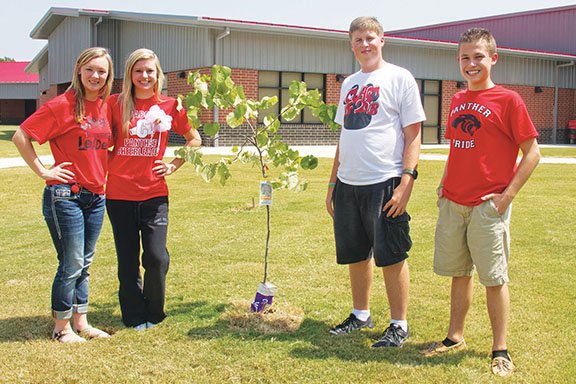CABOT — Freshmen at Cabot High School have a new academic home this year, and several students talked about how exciting it is to see some of the suggestions and recommendations they made for the school being adapted in the new building.
Classes began in the Cabot Freshman Academy on Aug. 18. Until this year, ninth-graders in the Cabot Public Schools were either at Cabot Junior High School North or Cabot Junior High School South.
The district built the Cabot Freshman Academy in order to make more room at the junior high schools and give freshmen a chance to unify as a class before moving across the street to the main high school.
“We can talk and build better
relationships with other ninth-graders,” student Jerry Griffin said. “Since it’s North and South combined, we can have better relationships before we move to the high school.”
Griffin was part of the student
leadership team formed last school year to help students, teachers and administrators form an executable vision for the new school.
Sixty members of the 2018 graduating class are on that team, and their influence can be seen throughout the school.
“I’m really impressed to have 60 kids who stood up, gave up part of their summer to come in and meet with us,” said Tanya Spillane, Cabot Freshman Academy principal.
“They’ve invested in this building. It’s not any one person who has made all of this happen; it’s a collective effort because of these kids.”
The student leadership team helped with the school’s open house, planted trees in the courtyard, helped other students on the first day of classes and generally serve as a voice for the student body when administrators make decisions about the new school.
Jesse Jeffers said he has enjoyed seeing the obvious impact that some of the suggestions he and others on the leadership team offered are making on the school.
“In this school, I’ve seen the things that we’ve voted on be changed,” he said. Some of those suggestions include the material shown on the television screens in the halls and in the cafeteria; an adequate number of electrical plugs in study areas; and a concerted effort to foster and improve student/teacher relations.
“We asked them the No. 1 thing they wanted to accomplish this year, and they said it was to form better relationships with the teachers,” Spillane said.
“One student stood up at one of our first meetings and said, ‘We want to know what our teachers are like. And we want them to know us and know when we’re having a bad day.’”
Because of this input, Spillane said, teachers agreed to write short autobiographies before the open house so the students could get to know them a little bit before getting into the school year.
“Every teacher — all 83 faculty members — had their own bio printed out there so people could find out what they like to do in their spare time, what they like to do for fun and what makes them tick,” she said. “And that’s because of the student leadership’s suggestion.”
After the first week of school, some students said they could already tell they were going to enjoy working with their teachers. One major factor in that mutual appreciation comes with the transition from junior high school to high school: Both teachers and students realize that high school is more than classes, and students said they appreciate it when teachers understand extracurricular schedules.
“All my teachers are nice and friendly, and they understand that school isn’t the only thing we have in our life,” said student-leadership team member Autumn Klein, who is also a cheerleader and a member of the forensics team.
“They’re able to work with us. If we have a test one day, they talk to the other teachers and coordinate so we don’t have to study for three tests on one day and have a game that night.”
Spillane said the first two days of class were spent on team building, not rules and procedures. This helped break the ice between teachers and students and let students who went to different junior high schools get to know each other.
The new school provides opportunities to meet needs that surfaced in other buildings. Griffin and Klein are both on the forensics team, and they said that in junior high, they had to practice their speeches in the hallway and would sometimes disrupt classes. Now, there is a much bigger space dedicated to the forensics team, giving members the privacy and room they need to practice.
Jeffers said he has been excited about the use of technology in the new building. Aside from the televisions in the hallways that display announcements and other school-friendly content, classrooms are equipped with tablets and Chromebooks.
“I think there are better resources,” he said. “It’s easier to use, and I’ve noticed less ‘no name’ problems. The last couple days in my science class, we’ve been doing assignments and submitting them through the Google Drive, so everyone gets it in.”
Ultimately, Spillane said, she wants to make sure the ninth-graders get the best experience possible at the Cabot Freshman Academy.
“It’s their school. This is their only shot at ninth grade,” she said. “I’ll be here for a while, but they won’t. They get one shot, and we’ve got to make it count.”
Staff writer Angela Spencer can be reached at (501) 244-4307 or aspencer@arkansasonline.com.
